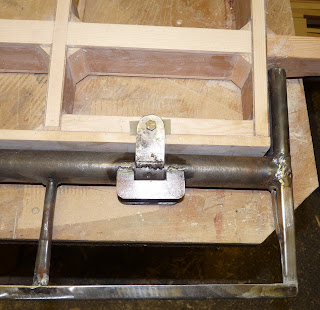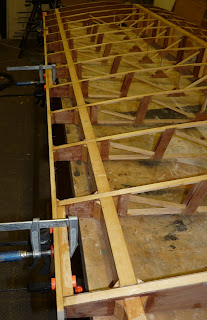
Over the last few days I have been slowly gluing up the left wing. So far the inner leading edge and the strengthening gussets, the aileron spar and gussets, and the main and rear upper spar caps have all been glued into place. In addition the bushings for the strut attach bracket bbolts have been glued into place and drilled and one of the 1/4" 12-ply plates glued and drilled. Remaining

to do are the lower spar caps, the leading edge to the root rib, and the strut attach ply plate. Then it's time to sand......
While waiting for the glue to dry, I've used the CNC router with a special purpose aluminium cutting endmill to cut out a 1/2" thick propellor crush plate to match the SAE#1 propellor drive on the engine . In the bottom picture you can just see the holding tabs that keep the piece together as the mill cuts. The bolt holes are 3/8" diameter and are cut using the 1/4" mill bit using a special spiral descending cutting action. It still seems remarkable that a home made CNC router made

out of MDF can cut to this accuracy. Total cost £7.00 for the piece of aluminium stock.
 As per advice a small amount of dihedral (0.2 degrees) was introduced to both wings. This is to allow some shrinkage in the struts when the top is welded. Then the wing struts were attached to the fuselage and marked to length with the top level with the centres of the bolt holes in the strut attach brackets. The wing struts were then cut to length and the front and rear edges notched to fit between the brackets. Next sections of douglas fir were cut and planed to fit into the struts. These protect against any possibility of compression failure under negative G loads. Two sections of 1/2" x 0.065" tubing were cut to length the fit between the strut attach brackets and reamed out to take a 3/8" bolt to act as bushings at the top of the strut and then bolted into place. The end of the strut was then flattened to fit neatly against the tubing and the dihedral rechecked. With everything set up as required the struts were then tack welded to the bushing. The temporary wing supports were removed leaving the wings mounted via the three bolts which will hold them in flight. Finally it was all dismantled again. Next job is to final weld the top of the struts.
As per advice a small amount of dihedral (0.2 degrees) was introduced to both wings. This is to allow some shrinkage in the struts when the top is welded. Then the wing struts were attached to the fuselage and marked to length with the top level with the centres of the bolt holes in the strut attach brackets. The wing struts were then cut to length and the front and rear edges notched to fit between the brackets. Next sections of douglas fir were cut and planed to fit into the struts. These protect against any possibility of compression failure under negative G loads. Two sections of 1/2" x 0.065" tubing were cut to length the fit between the strut attach brackets and reamed out to take a 3/8" bolt to act as bushings at the top of the strut and then bolted into place. The end of the strut was then flattened to fit neatly against the tubing and the dihedral rechecked. With everything set up as required the struts were then tack welded to the bushing. The temporary wing supports were removed leaving the wings mounted via the three bolts which will hold them in flight. Finally it was all dismantled again. Next job is to final weld the top of the struts.































